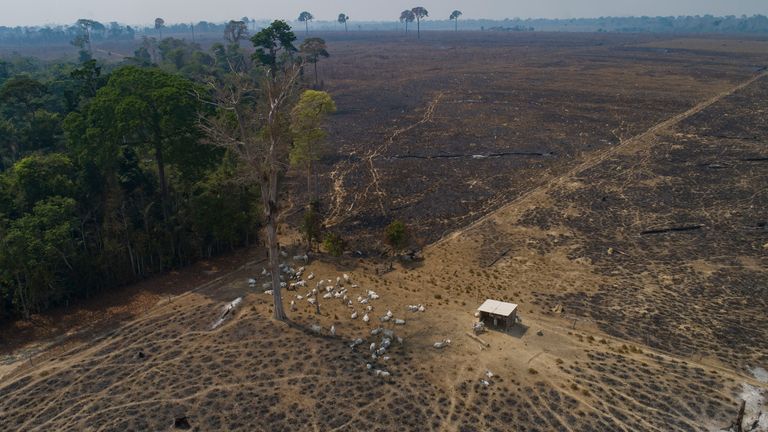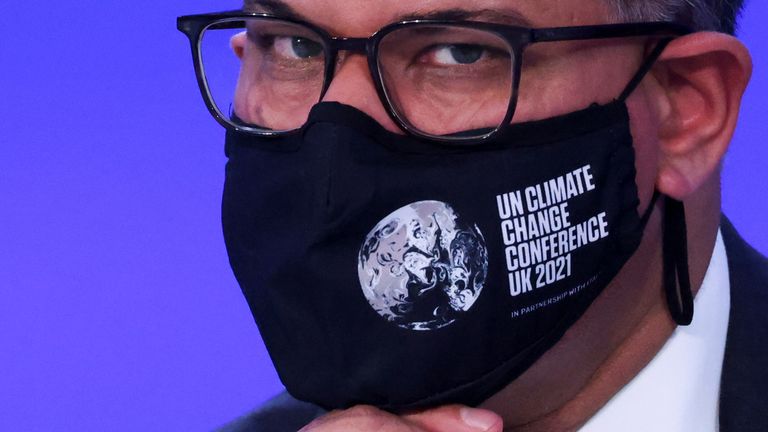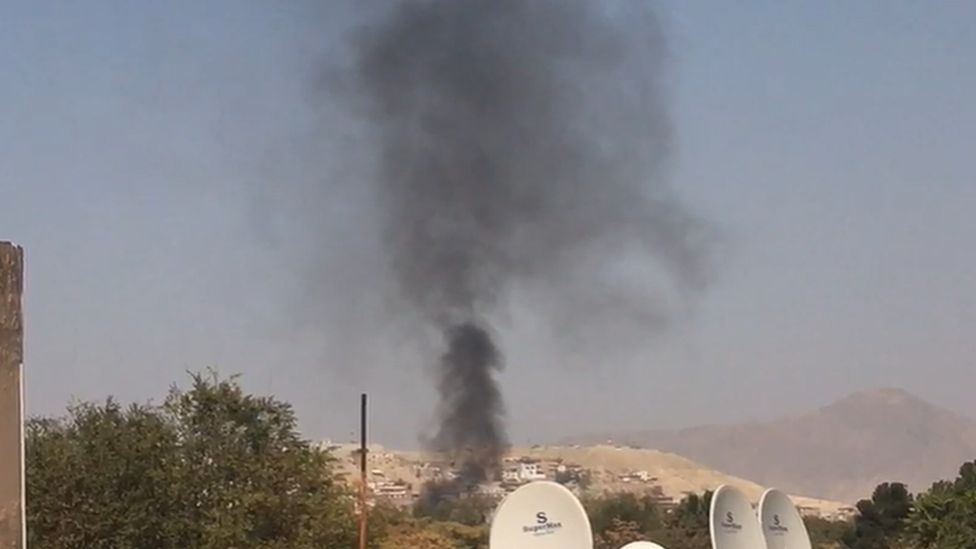More than 100 leaders representing 85% of the world’s forests will commit to stopping and reversing deforestation by 2030 in a “significant breakthrough” on the road to tackling the climate crisis.
Countries including Brazil, Russia, Canada, Colombia, Indonesia and the Democratic Republic of the Congo will sign the pledge on Tuesday, which is backed by £14bn ($19.2bn) in public and private funding.
Environment Secretary George Eustice hailed the pledge as a “major step forward” and told Sky News the deforestation deal offered greater hope of the two-week COP26 summit ending in wider action by nations.
Previously, Prime Minister Boris Johnson and other cabinet ministers had been downbeat about the chances of the Glasgow conference ending with substantial action.
But speaking to Sky News on the second day of COP26, Mr Eustice said: “I think it’s a really encouraging sign that this early on… actually many of those countries have come forward and said ‘we’re up for doing this’.”
“This is a really significant breakthrough,” he added.
The prime minister has been hoping the summit would deliver on priority areas he sees as “coal, cash, cars and trees,” so this pledge will tick the trees box.
But the government as host has set the conference’s aim to “keep 1.5 degrees alive” and there is still a long way to go on a deal to make the necessary emissions cuts.
Announcing the “landmark agreement” on forests at COP26 on Tuesday, Mr Johnson will say: “These great teeming ecosystems… are the lungs of our planet [and] … essential to our very survival.
“With today’s unprecedented pledges, we will have a chance to end humanity’s long history as nature’s conqueror, and instead become its custodian.”
Forests play an essential role in fighting the climate crisis, absorbing vast amounts of planet-heating carbon dioxide from the air, and provide food, jobs and homes.
But campaigners say they are being lost at an alarming rate of one football pitch every two seconds through activities such as commodities, agriculture, urbanization, wildfire and forestry.
The new money behind the Glasgow Leaders’ Declaration on Forests and Land Use will help restore degraded land, tackle wildfires and support the rights of indigenous communities.
Many welcomed the acknowledgement of indigenous peoples as crucial guardians of forests.
Tuntiak Katan, coordinator of the Global Alliance of Territorial Communities, representing communities from the rainforests of Africa, Latin America and Indonesia, said the announcement raised the visibility of indigenous peoples and local communities as a climate solution to an “unprecedented level”.
Roberto Waack, Brazilian business leader and biologist and a Chatham House visiting fellow, called the deal a “significant milestone”.
“Today we celebrate – tomorrow we will start pressing for the deal to be delivered,” he said.
CEOs from more than 30 financial institutions will also promise to stop investing in activities linked to deforestation.
The last similar pledge, the New York Declaration on Forests, signed in 2014, promised to halve tropical deforestation and restore 150 million hectares of land by 2020.
However, most countries did not follow through, and since then tropical primary forest loss has generally increased, according to a progress report published in October.
To harness the potential of forests to help the world meet the Paris temperature goal, dramatic shifts in food production, agriculture and land use will be needed.
This is the first major announcement unveiled at the UN climate talks, which aim to “keep alive” the Paris Agreement target of limiting warming to 1.5C. Another is expected soon on cutting methane, a climate-heating gas.
World leaders delivered statements on their own plans to meet the Paris Agreement, with further speeches expected on Tuesday from the leaders of Pakistan, Argentina, Colombia and Japan.
They will provide the tone and guidance for the negotiators seeking to thrash out deals in the rest of the two-week summit.
President Biden said in his speech on Monday that those “responsible for much of the deforestation and all of the problems we have so far” have “overwhelming obligations” to the poorer nations that account for few of the emissions yet are paying a price as the planet has grown hotter.
India’s prime minister, Narendra Modi, said his country would aim to stop adding greenhouse gases to the atmosphere by 2070 – two decades after the US and the UK – and at least 10 years later than China.
The full list of signatories to the Glasgow Leaders Declaration on Forest and Land Use (as of 1 November 2021) are:
Albania, Andorra, Angola, Armenia, Australia, Austria, Belgium, Belize, Bhutan, Bosnia and Herzegovina, Botswana, Brazil, Bulgaria, Cameroon, Canada, Chile, China, Colombia, Costa Rica, Cote D’Ivoire, Cyprus, Denmark, Dominican Republic, Democratic Republic of the Congo, European Union, Ecuador, Estonia, Fiji, Finland, France, Gabon, Germany, Ghana, Guatemala, Guinea Bissau, Guyana, Honduras, Iceland, Indonesia, Ireland, Israel, Italy, Japan, Kazakhstan, Kenya, Kyrgyzstan, Latvia, Liberia, Liechtenstein, Lithuania, Luxembourg, Madagascar, Malawi, Mali, Malta, Mauritius, Monaco, Mongolia, Montenegro, Morocco, Mozambique, Nepal, Netherlands, New Zealand, Niger, Nigeria, North Macedonia, Norway, Pakistan, Panama, Papua New Guinea, Peru, Poland, Portugal, Republic of Congo, Romania, Russia, Saint Lucia, Samoa, San Marino, Seychelles, Sierra Leone, Slovakia, Slovenia, South Korea, Spain, Sri Lanka, Suriname, Sweden, Tanzania, Togo, Turkey, United Arab Emirates, Ukraine, Uruguay, United Kingdom, United States of America, Vanuatu, Vietnam, Zambia, Zimbabwe.















